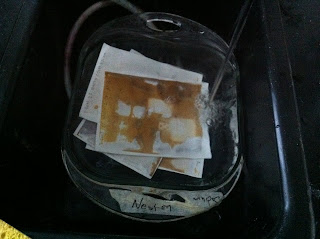What we got in this experment:
1. 2% salt solution
2. 5% salt solution
3. 5% silver nitrate solution
4. 12% silver nitrate solution
5. destill water
6. water color paper
Process
My group provide the 2% salt solution by using 2g salt dissolve in 100 ml destill water. Ang we will get the other soltion provide by other group.
Get done 12 test paper
1. 1 Coated of 2% Salt 1 Coated of 5 % Silver Nitrate
2. 1 Coated of 2% Salt 1 Coated of 12 % Silver Nitrate
3. 2 Coated of 2 % Salt 1 Coated of 5% Silver Nitrate
4. 2 Coated of 2% Salt 1 Coated of 12% Silver Nitrate
5. 2. Coated of 2% Salt 2 Coated of 5% Silver Nitrate
6. 2 Coated of 2% Salt 2 Coated of 12% Silver Nitrate
7. 1 Coated of 5% Salt 1 Coated of 5% Silver Nitrate
8. 1 Coated of 5% Salt 1 Coated of 12% Silver Nitrate
9. 1 Coated of 5% Salt 2 Coated of 5% Silver Nitrate
10. 1 Coated of 5% Salt 2 Coated of 12% Silver Nitrate
11. 2 Coated of 5% Salt 2 Coated of 5 % Silver Nitrate
12. 2 Coated of 5% Salt 2 Coated of 12% Silver Nitrate
We use dropper to drop the solution and use brush to apply the solution vertical and horizantal to get evenly coat, then use hairdryer to dry the paper, if it is needed, we put another coat, also, dry it.
After all 12 pieces are done, we put some items on the paper then go outside to explode 5min. The pics above show the reaction, when the paper get the sunlight dreictly, it's getting dark.
















